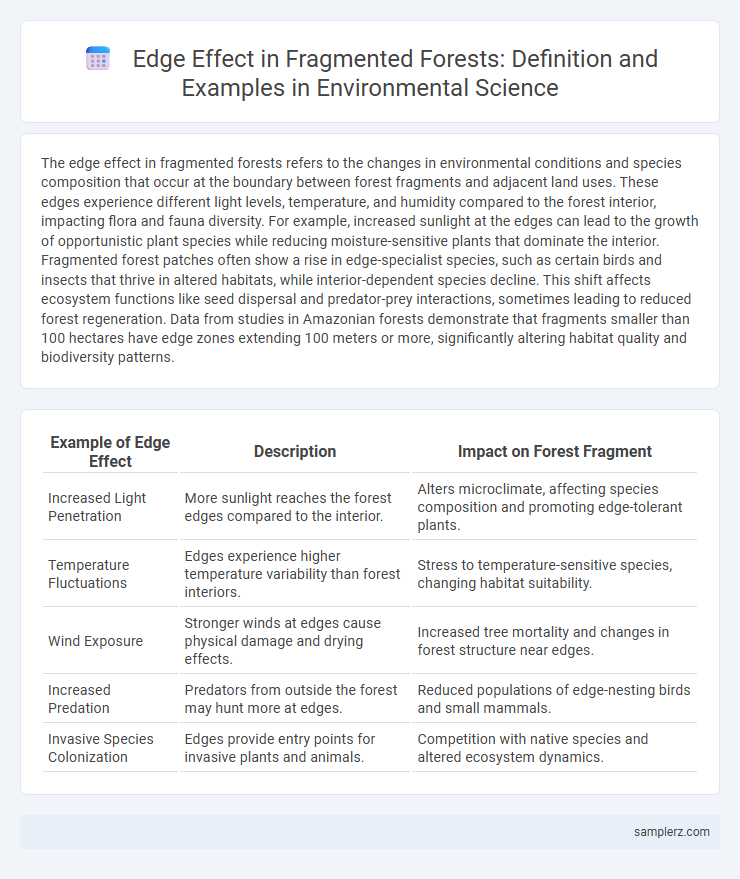The edge effect in fragmented forests refers to the changes in environmental conditions and species composition that occur at the boundary between forest fragments and adjacent land uses. These edges experience different light levels, temperature, and humidity compared to the forest interior, impacting flora and fauna diversity. For example, increased sunlight at the edges can lead to the growth of opportunistic plant species while reducing moisture-sensitive plants that dominate the interior. Fragmented forest patches often show a rise in edge-specialist species, such as certain birds and insects that thrive in altered habitats, while interior-dependent species decline. This shift affects ecosystem functions like seed dispersal and predator-prey interactions, sometimes leading to reduced forest regeneration. Data from studies in Amazonian forests demonstrate that fragments smaller than 100 hectares have edge zones extending 100 meters or more, significantly altering habitat quality and biodiversity patterns.
Table of Comparison
| Example of Edge Effect | Description | Impact on Forest Fragment |
|---|---|---|
| Increased Light Penetration | More sunlight reaches the forest edges compared to the interior. | Alters microclimate, affecting species composition and promoting edge-tolerant plants. |
| Temperature Fluctuations | Edges experience higher temperature variability than forest interiors. | Stress to temperature-sensitive species, changing habitat suitability. |
| Wind Exposure | Stronger winds at edges cause physical damage and drying effects. | Increased tree mortality and changes in forest structure near edges. |
| Increased Predation | Predators from outside the forest may hunt more at edges. | Reduced populations of edge-nesting birds and small mammals. |
| Invasive Species Colonization | Edges provide entry points for invasive plants and animals. | Competition with native species and altered ecosystem dynamics. |
Introduction to Edge Effect in Fragmented Forests
Edge effect in fragmented forests refers to the changes in microclimate, species composition, and ecological processes that occur at the boundary between forest patches and surrounding non-forest areas. These edges often experience increased sunlight, wind exposure, and temperature fluctuations, leading to altered habitats that favor edge-adapted species over interior forest specialists. Fragmentation intensifies edge effects, resulting in decreased biodiversity, disrupted animal movement, and increased vulnerability to invasive species within forest ecosystems.
Microclimate Changes at Forest Edges
Microclimate changes at forest edges in fragmented landscapes lead to higher temperatures, increased light intensity, and lower humidity compared to interior forest conditions. These alterations disrupt native species' physiological processes, promote invasive species colonization, and increase edge vulnerability to drought stress. Studies in Amazonian fragments show temperature gradients extending up to 100 meters from the edge, significantly affecting seedling survival and carbon cycling.
Increased Invasion by Non-Native Species
Fragmented forests exhibit pronounced edge effects, leading to increased invasion by non-native species such as Japanese knotweed and garlic mustard. These invasive plants thrive in altered microclimates at forest edges, where light penetration and temperature fluctuations facilitate their rapid spread. The proliferation of non-native species disrupts native biodiversity, alters nutrient cycling, and compromises forest ecosystem stability.
Altered Species Composition Near Edges
Fragmented forests exhibit pronounced edge effects, leading to altered species composition near forest edges where increased sunlight and wind penetration favor opportunistic and edge-adapted species, often reducing interior forest specialists. These changes create microhabitats with different temperature and humidity levels, promoting invasive plants and altering native wildlife populations. Such shifts can decrease biodiversity and disrupt ecological processes vital to forest health.
Impacts on Animal Movement and Behavior
Fragmented forests create edge effects that significantly alter animal movement and behavior by increasing exposure to predators and changing microclimatic conditions. Species such as jaguars and songbirds exhibit altered foraging patterns and reduced territorial ranges near forest edges, leading to decreased reproductive success. These behavioral shifts contribute to population declines and disrupt ecosystem dynamics within fragmented habitats.
Changes in Predator-Prey Interactions
Fragmented forests exhibit pronounced edge effects that alter predator-prey interactions by increasing predator access and visibility to prey species near forest edges. Species such as bobcats and raccoons often exploit these edges to hunt more efficiently, leading to elevated predation rates on small mammals and bird nests. This shift disrupts traditional prey behavior and population dynamics, contributing to decreased biodiversity within fragmented habitats.
Elevated Tree Mortality and Disturbance
Fragmented forests exhibit intensified edge effects, where elevated tree mortality occurs due to increased exposure to wind, sunlight, and temperature fluctuations at forest boundaries. Disturbances such as invasive species invasion and altered microclimate further stress tree populations near edges, accelerating dieback and reducing forest resilience. Research shows tree mortality rates near forest edges can be up to five times higher than in interior forest areas, significantly impacting ecosystem stability.
Edge Effect on Plant Reproduction and Growth
Edge effects in fragmented forests significantly alter microclimatic conditions such as light, temperature, and humidity, impacting plant reproduction and growth. Increased sunlight and wind exposure at forest edges often lead to higher seed desiccation and reduced seedling survival rates, disrupting natural regeneration processes. These environmental stresses favor edge-adapted or invasive plant species, which can further modify species composition and ecosystem dynamics in fragmented habitats.
Biodiversity Loss in Fragmented Forest Edges
Fragmented forest edges create microclimatic changes such as increased light, wind, and temperature fluctuations that disrupt habitat conditions, leading to a decline in sensitive species and overall biodiversity loss. Edge effects facilitate the invasion of opportunistic species, outcompeting native flora and fauna and reducing ecosystem complexity. These shifts contribute to reduced genetic diversity and altered community structures, threatening long-term forest resilience and ecological stability.
Restoration Strategies to Mitigate Edge Effects
Restoration strategies to mitigate edge effects in fragmented forests include the establishment of buffer zones with native vegetation to reduce microclimatic changes and invasive species incursion. Reforestation efforts using diverse native species improve habitat connectivity and stabilize the ecosystem's structural integrity. Active management techniques such as controlled burns and invasive species removal further restore core forest conditions and support biodiversity resilience.

example of edge effect in fragmented forest Infographic
 samplerz.com
samplerz.com